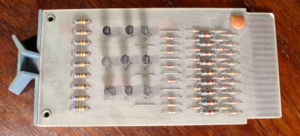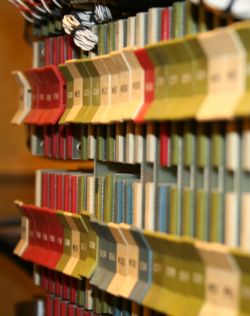FLIP CHIP

FLIP CHIP was DEC's trade name (a registered trademark for DEC) for a lengthy series of DEC's small cards used to build computers, and peripherals for them. They were a successor to DEC's earlier System Modules. They were introduced as a replacement largely as a cost-reduction measure, using cheaper etch fingers, as opposed to connectors (ironic, since their eventual demise was also due to cost-reduction).
Early FLIP CHIP modules were single-height, normal-length modules, approximately 4 inches long and 2.5 inches wide. These had 18 contact fingers on one side of the PCB only (the so-called 'solder' side); the contact pads were 'numbered' from the DEC Alphabet. A FLIP CHIP plugged directly into a 144-pin connector block backplane with wire-wrap pins on the back side; automatic Gardner-Denver wire-wrapping equipment could wire the connector blocks to produce larger functional (sub)-systems.
The earliest FLIP CHIPs, introduced on August 24, 1964, used discrete transistors and diodes; they performed generic, simple logic functions, similar to an integrated circuit. FLIP CHIPs incorporating IC technology eventually followed, and the limited number of contact pins eventually became a problem, so that contact fingers were added on the other ('component') side as well, for a total of 36 connectors, 18 on each side.
FLIP CHIPs were used in the DEC PDP-7 (referred to in its documentation as the "FLIP CHIP"), PDP-8, PDP-9 and PDP-10. DEC continued to use the name up into the period when extended-length quad-height cards started to appear, e.g. in the KA11 CPU. However, although these special-purpose cards are labelled 'FLIP CHIP's (and continued to use the initial letter coding), they are generally not considered to be 'true' FLIP CHIPS; the name is generally only used to refer to the smaller, general-purpose cards.
The small, general-purpose FLIP CHIPs made sense when they were first introduced (in the transistor era), since they allowed designers to operate at a higher conceptual level (gates, etc). In the IC era, those became the design elements, and it also became desirable, for cost reasons, to decrease the amount of connectors used in a (sub)-system, so the larger cards became the preferred direction.
Contents
Naming
There appeared to be some confusion inside DEC at the time, as various manuals refer to it as "FLIP CHIP", "Flip Chip", "FLIP-CHIP", "Flip-Chip" and "Flip Chip", with trademark and registered trademark symbols.
(They should not be confused with the generic technology term 'flip chip'; the DEC version, properly spelled with all capital letters, as in the trademark filing, got its name from the fact that some early FLIP CHIPs used flip chips. The latter was a component mounting technique which quite rapidly faded. The name was retained although the majority of FLIP CHIPs never were flip chip-mounted, as it quickly became apparent that the flip chip mounting technique was highly un-reliable.)
Flip-Chip families

The following FLIP CHIP families ('series', in DEC terminology) were introduced over the years. The handles of the various series were colour-coded: the first letter of the identification denoted a colour, which was the colour of the plastic which the handle(s) were formed out of.
A series
See the list of DEC parts.
The A stands for 'Amber'. The A series were used for analog functions - ADCs, DACs, amplifiers etc.
- Typical price $350 to $750 (08/67 price list)
B series
The B stands for 'Blue'; they were effectively the same as the 6000 Series System Modules, but re-packaged into FLIP CHIP form. First used on the PDP-7, and later in the famous KA10 PDP-10 CPU; they used silicon transistors, and were used for the main logic in the higher-end CPUs.
- Power supply: +10 and -15 volts
- Operational to 10 megahertz
- Signal level 0 volts, logic 0 and -3 volts, logic 1
- Typical price $15 to $57 (10/65 price list)
G series
The G stands for 'Green' (the handles are an olive green, not a forest green, though). The G series were specialized modules that are part of a specific larger (sub)-system (e.g. core memory drivers).
K series
The K stands for 'Black' (blacK handles); they were used in industrial control applications, and could tolerate higher voltages, more noise, etc.
M series
See the list of DEC parts.
The M stands for 'Magenta' (a purple colour). When first introduced, they carried the then-new TTL chips; they were first used in the PDP-8/I. Later on, they became quite complex (see list of DEC part numbers). They replaced the R and S series.
- Power supply: +5 V
- Operate at up to 6 MHz
- Signal level 0 volts, logic 0 and +3 volts, logic 1
- Typical price $23 to $84 (08/67 price list)
R series
The first FLIP CHIP family; R stands for 'Red'. They used discrete transistors; intended to be easy to use, they used diode gates and diode-capacitor-diode circuits. They were slower logic than the B series, but cheaper. They were used extensively in the I/O circuitry of computers.
- Power supply +10 and -15 volts
- Operational to 2 megahertz
- Signal level 0 volts, logic 0 and -3 volts, logic 1
- Typical price $15 to $47 (10/65 price list)
S series
The S series (also with red handles) is identical to the R series, except that its transistors switched faster, and it also used lower resistance resistors, allowing more cards to be wired in series, and also operate somewhat faster. First developed for the original PDP-8.
W series
The W stands for 'White'. These are components that plug into connector block slots that can hold a FLIP CHIP, but have no logic of their own; they are used for input/output to external circuitry.
See also
Further reading
- FLIP CHIP Modules, Digital Equipment Corporation, Maynard, September, 1964 (C-105)
- Digital FLIP CHIP Modules, Digital Equipment Corporation, Maynard, February, 1965 (C-105)
- FLIP CHIP Modules Price List, Digital Equipment Corporation, Maynard, October, 1965 (C-105)
- M Series Modules, Digital Equipment Corporation, Maynard, February, 1967
- Digital Logic Handbook (1977-78), Digital Equipment Corporation, Maynard, 1977
External links
- modules - FLIP CHIP documentation at Bitsavers
- B Series
- G Series
- K Series
- M Series
- R Series
- S Series
- W Series
- Spare Module Handbook (March 1976) - Lists which FLIP CHIPs are used in many subsystems
- PDP-15 Module Manual - Contains many M-series modules
- Engineering Drawings Manual 1 - B and G series cards
- Engineering Drawings Manual 2 - M, R, S and W series cards
- handbooks - more FLIP CHIP documentation
- Richard L. Best, Russell C. Doane and John E. McNamara, Digital Modules, The Basis for Computers, in C. Gordon Bell, J. Craig Mudge, John. E. McNamara, Computer Engineering: A DEC View of Hardware Systems Design, Digital Press, Bedford, 1978
- In the Beginning and linked subsequent pages
- Digital FlipChip Technology
- FlipChip Modules - Large database of detailed FLIP CHIP information
- Flip-Chip Shop